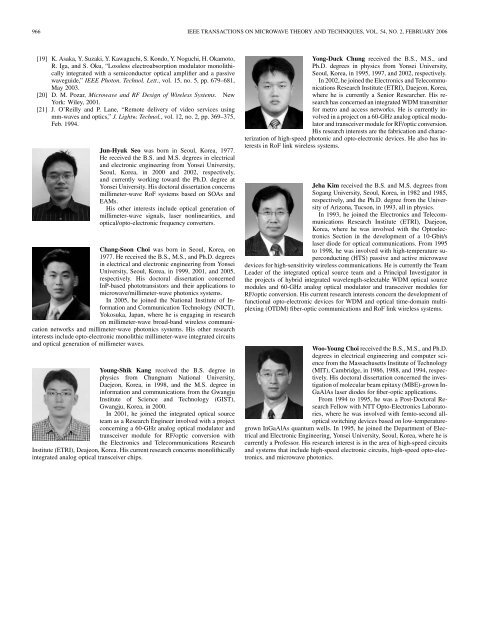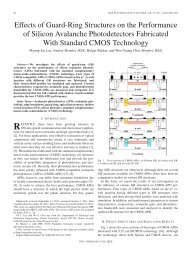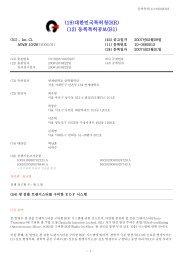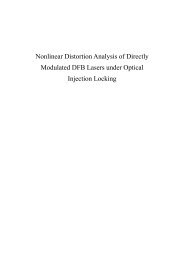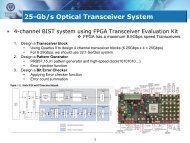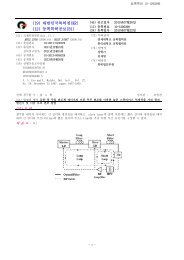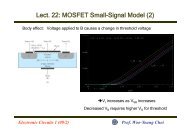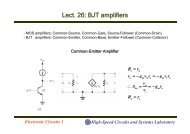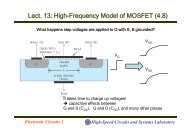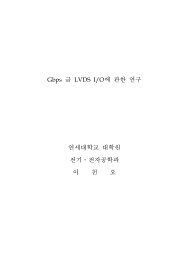SOA–EAM Frequency Up/Down-Converters for 60 ... - IEEE Xplore
SOA–EAM Frequency Up/Down-Converters for 60 ... - IEEE Xplore
SOA–EAM Frequency Up/Down-Converters for 60 ... - IEEE Xplore
Create successful ePaper yourself
Turn your PDF publications into a flip-book with our unique Google optimized e-Paper software.
966 <strong>IEEE</strong> TRANSACTIONS ON MICROWAVE THEORY AND TECHNIQUES, VOL. 54, NO. 2, FEBRUARY 2006[19] K. Asaka, Y. Suzaki, Y. Kawaguchi, S. Kondo, Y. Noguchi, H. Okamoto,R. Iga, and S. Oku, “Lossless electroabsorption modulator monolithicallyintegrated with a semiconductor optical amplifier and a passivewaveguide,” <strong>IEEE</strong> Photon. Technol. Lett., vol. 15, no. 5, pp. 679–681,May 2003.[20] D. M. Pozar, Microwave and RF Design of Wireless Systems. NewYork: Wiley, 2001.[21] J. O’Reilly and P. Lane, “Remote delivery of video services usingmm-waves and optics,” J. Lightw. Technol., vol. 12, no. 2, pp. 369–375,Feb. 1994.Jun-Hyuk Seo was born in Seoul, Korea, 1977.He received the B.S. and M.S. degrees in electricaland electronic engineering from Yonsei University,Seoul, Korea, in 2000 and 2002, respectively,and currently working toward the Ph.D. degree atYonsei University. His doctoral dissertation concernsmillimeter-wave RoF systems based on SOAs andEAMs.His other interests include optical generation ofmillimeter-wave signals, laser nonlinearities, andoptical/opto-electronic frequency converters.Chang-Soon Choi was born in Seoul, Korea, on1977. He received the B.S., M.S., and Ph.D. degreesin electrical and electronic engineering from YonseiUniversity, Seoul, Korea, in 1999, 2001, and 2005,respectively. His doctoral dissertation concernedInP-based phototransistors and their applications tomicrowave/millimeter-wave photonics systems.In 2005, he joined the National Institute of In<strong>for</strong>mationand Communication Technology (NICT),Yokosuka, Japan, where he is engaging in researchon millimeter-wave broad-band wireless communicationnetworks and millimeter-wave photonics systems. His other researchinterests include opto-electronic monolithic millimeter-wave integrated circuitsand optical generation of millimeter waves.Young-Shik Kang received the B.S. degree inphysics from Chungnam National University,Daejeon, Korea, in 1998, and the M.S. degree inin<strong>for</strong>mation and communications from the GwangjuInstitute of Science and Technology (GIST),Gwangju, Korea, in 2000.In 2001, he joined the integrated optical sourceteam as a Research Engineer involved with a projectconcerning a <strong>60</strong>-GHz analog optical modulator andtransceiver module <strong>for</strong> RF/optic conversion withthe Electronics and Telecommunications ResearchInstitute (ETRI), Deajeon, Korea. His current research concerns monolithicallyintegrated analog optical transceiver chips.Yong-Duck Chung received the B.S., M.S., andPh.D. degrees in physics from Yonsei University,Seoul, Korea, in 1995, 1997, and 2002, respectively.In 2002, he joined the Electronics and TelecommunicationsResearch Institute (ETRI), Daejeon, Korea,where he is currently a Senior Researcher. His researchhas concerned an integrated WDM transmitter<strong>for</strong> metro and access networks. He is currently involvedin a project on a <strong>60</strong>-GHz analog optical modulatorand transceiver module <strong>for</strong> RF/optic conversion.His research interests are the fabrication and characterizationof high-speed photonic and opto-electronic devices. He also has interestsin RoF link wireless systems.Jeha Kim received the B.S. and M.S. degrees fromSogang University, Seoul, Korea, in 1982 and 1985,respectively, and the Ph.D. degree from the Universityof Arizona, Tucson, in 1993, all in physics.In 1993, he joined the Electronics and TelecommunicationsResearch Institute (ETRI), Daejeon,Korea, where he was involved with the OptoelectronicsSection in the development of a 10-Gbit/slaser diode <strong>for</strong> optical communications. From 1995to 1998, he was involved with high-temperature superconducting(HTS) passive and active microwavedevices <strong>for</strong> high-sensitivity wireless communications. He is currently the TeamLeader of the integrated optical source team and a Principal Investigator inthe projects of hybrid integrated wavelength-selectable WDM optical sourcemodules and <strong>60</strong>-GHz analog optical modulator and transceiver modules <strong>for</strong>RF/optic conversion. His current research interests concern the development offunctional opto-electronic devices <strong>for</strong> WDM and optical time-domain multiplexing(OTDM) fiber-optic communications and RoF link wireless systems.Woo-Young Choi received the B.S., M.S., and Ph.D.degrees in electrical engineering and computer sciencefrom the Massachusetts Institute of Technology(MIT), Cambridge, in 1986, 1988, and 1994, respectively.His doctoral dissertation concerned the investigationof molecular beam epitaxy (MBE)-grown In-GaAlAs laser diodes <strong>for</strong> fiber-optic applications.From 1994 to 1995, he was a Post-Doctoral ResearchFellow with NTT Opto-Electronics Laboratories,where he was involved with femto-second allopticalswitching devices based on low-temperaturegrownInGaAlAs quantum wells. In 1995, he joined the Department of Electricaland Electronic Engineering, Yonsei University, Seoul, Korea, where he iscurrently a Professor. His research interest is in the area of high-speed circuitsand systems that include high-speed electronic circuits, high-speed opto-electronics,and microwave photonics.


